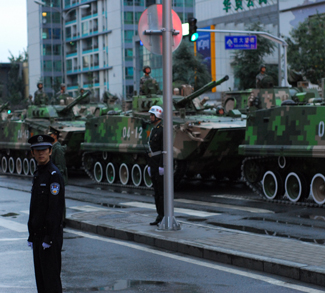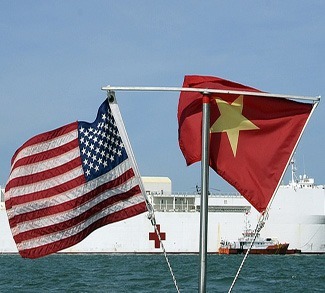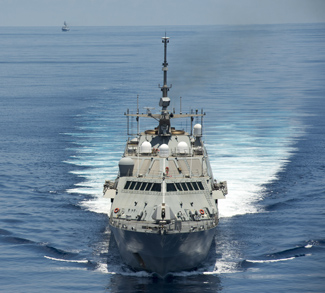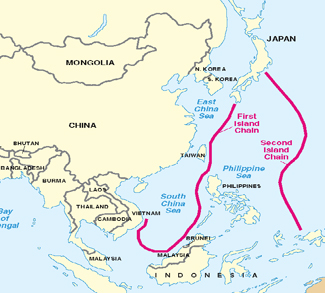In early September, China will once again showcase its military might as it gets set to mark the 70th anniversary of World War II with a massive parade in Beijing. Military parades of such scale are usually reserved for every tenth anniversary of the founding of the country, with the last being held in 2009 in Tiananmen Square under the leadership of then-president Hu Jintao. While the goose-stepping troops and new military hardware of the People’s Liberation Army (PLA) are expected to be the centrepiece of the parade, this event also seeks to reinforce China’s image abroad, both in economic and military terms.
For the Communist Party, the significance of this event goes beyond the Square, as it also aims at reinventing Chinese identity under the leadership of President Xi Jinping. Though a defence ministry spokesman, Geng Yansheng said the parade is to “commemorate victims of World War II” and demonstrate its firm stance with the rest of the world to “maintain world peace and stability.” Speculation is already rife that the parade will also serve as a warning to its critics such as Japan or even the Philippines against a backdrop of territorial disputes in regional waters.
Geopolitical Considerations
In a historical context, the military parade by China will send a message to Japan over the latter’s refusal to admit its war-time aggression, a thorny issue that has dominated the relationship of the two giants in the past. For Beijing, Japan’s lack of remorse over the atrocities committed during the World War II era necessitates it to constantly highlight this issue via different means in order to prevent the latter from rewriting history by whitewashing past military aggression. With the declaration of September 3 as “Victory Day of the Chinese People’s War of Resistance against Japanese Aggression” by the legislature last year, Beijing is definitely ramping up pressure on Japan to do more in addressing this issue with this military parade, where many world leaders are expected to be present.
While historical events serve as the official reason to hold this parade, China is also using this opportunity to warn the current leadership of Japan to back off from its nationalistic agenda to revise Article 9 of the constitution and instead adheres to its pacifist path that prohibits the Self Defence Forces from striking the first blow. In the eyes of China, Japanese attempt to revise the constitution is a direct threat as it was aimed at containing Beijing’s growing clout in the increasingly tense Asia-Pacific region. The decision by Japanese Prime Minister Shinzo Abe last year to reinterpret the country’s pacifist constitution, thus allowing its military to aid friendly countries that come under attack, also adds to the Chinese reasoning for this military parade.
It is not only Japan that the Chinese have a message for. The parade to a certain extent also reminds the United States that Beijing is neither comfortable nor impressed with the “pivot” to Asia strategy announced by President Obama in 2011. As China is engaged in multiple territorial disputes with US allies in the East and South China Seas as well as the Taiwan issue, the parade also seeks to reinforce the message that Beijing will not rule out military option should situation spirals out of control and the United States must therefore play a constructive role in ensuring regional peace and stability. Furthermore, it is also a commonly-held view in China that countries like Japan and Philippines are able to antagonise it because the United States is using these countries to advance its containment agenda.
Soft Power on Display at the Military Parade
Although military strength will often be classified under the category of hard power, there is also a soft power dimension for China to hold this World War II commemoration parade. As disclosed by officials, foreign militaries will be invited for the first-time ever to participate in this massive parade, which usually takes place on 1 October to mark the country’s founding. According to official sources, both Russia and Mongolia have confirmed their participation for the event with reports claiming that China has also extended invitation to the two Koreas as well as Taiwan.
For China, the participation of foreign forces will bolster its reputation abroad as a great contributor to global peace, an element that has been critical to Beijing’s “peaceful rise” agenda. As the former leader Hu Jintao once stressed during the Communist Party Congress in 2007, China has been under what he described as “soft power assault” by Western media and Beijing will need to do more correct the misconception associated with its rise. With the expected attendance of world leaders, China is also keen to frame this event as an international parade that promotes the role its military forces play in global peacekeeping efforts instead of a showcase of latest military technologies as it did in the National Day parades.
A commentary in the state-run news agency, Xinhua confirmed this view when it quoted a senior military official who said that the parade “will convey to the world that China is devoted to safeguarding international order after World War II rather than challenging it.” The commentary further added that the presence of foreign dignitaries will boost China’s influence in the international arena, something it has invested heavily in over the past decade. As it appears, China does seem to be working toward elevating the status of this parade similar to the Victory Day in Russia or Bastille Day in France. The question is whether a successful parade will necessarily translate into better perception of a rising China among audiences abroad.
Military Parade shows Xi Jinping’s Growing Clout in Zhongnanhai
From the domestic politics perspective, the parade is yet another signal that Xi is cementing control over Zhongnanhai (the Chinese equivalent of the White House or the Kremlin) as well as the Communist Party as a whole. Since taking office in 2013, Xi has steadily consolidated his grip on power by purging once powerful senior officials such as Zhou Yongkang and Bo Xilai, launching a new doctrine called the “Chinese Dream” as well as moving away from the “collective leadership” style the party practised since the death of Mao.
In the case of the parade, Xi, who typically would have to wait for another four years for the one marking the country’s founding has instead chose to hold it now in order to show that the military is firmly under his control. While Hu struggled to consolidate power throughout his presidency, Xi’s meteoric rise according to analysts is matching that of Deng Xiaoping, who was considered as one of China’s most prominent leaders. Shortly after Deng took power, he similarly took the bold step to revive a military parade that has been put on hold for 25 years due to the Cultural Revolution and economic hardships among other reasons. The parade at Tiananmen Square in 1984 was a clear political message to others that Deng had emerged with a firm grip on power in the aftermath of chaos caused by the Gang of Four.
Xi’s ability to break the normal conventions can be interpreted as following Deng’s footsteps of quickly establishing a solid political base by taking command of numerous committees in party as well as neutralising critical elements including military and security that might become a threat to his leadership in the future. A successful parade will be vital for Xi to tell the domestic and international audiences that he is the commander-in-chief of the military and more importantly, the sole person-in-charge in the vast land of 1.3 billion people.
Though the exact details of the parade are still scant at the moment, the expected appearance of Russian President Vladimir Putin standing alongside Xi (just like Obama alongside Indian Prime Minister Narendra Modi at the Republic Day’s celebration in January) are already raising eyebrows among Western observers about the geopolitical message these leaders intend to send to the rest of the world. For others, it will be interesting to see if China will use this opportunity to showcase its latest military hardware including the DF-41 intercontinental ballistic missile, rumoured to be the world’s longest ranged missile, which failed to make an appearance during the 2009 parade.




